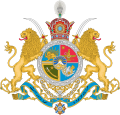National emblem of Iran
| National emblem of Iran | |
|---|---|

|
|
| Details | |
| Introduced | 1980 |
The Iran leads since the Islamic Revolution of 1979 no arms in the strict sense, but a national emblem ( Persian نشان رسمی ایران), which fulfills the function of a national emblem . It shows the word Allah (God) in stylized Persian-Arabic script .
description
The sign, reminiscent of calligraphic lettering, consists of four crescent moon and a sword. These five vertically arranged components symbolize the five pillars of Islam .
Above the tip of the sword there is a tashdid , the doubling sign of the Arabic script , which can be understood here as reinforcement of the power symbolized by the weapon.
As a whole, the sign can be used as a stylized signature Allah /الله / Allaah / read 'God'.
The symmetrical design is considered an expression of balance and stability.
Overall, the shape of the emblem is also reminiscent of a tulip blossom , a symbol rooted in Persian mythology, which refers to the idea that a tulip grows wherever the blood of a fighter for his country has been shed. In more recent times this myth has also been related to Islamic martyrdom by some interpreters .
The motif can also be found in the flag of Iran .
history
The emblem refers to Islam . It was created by Hamid Nadimi and approved by Ayatollah Khomeini on May 9, 1980 as a national emblem. It was created after the old emblem of Persia (lion with saber in front of the rising sun) , which had been used on the state flag , was abolished in the course of the Islamic Revolution and was to be replaced by a symbol that did not remind of the monarchical conditions.
The old imperial emblem is still valid as a protective symbol : red lion with red sun according to the Geneva Convention . Despite the switch to the Red Crescent in 1980, Iran continues to expressly reserve the right to use the Red Lion with the red sun.
Coat of arms of the Emperor of Iran under the Pahlavi Dynasty 1925–1979
Unicode
Today's emblem of Iran is included in the Unicode block Various symbols at code point U + 262B under the name "Farsi Symbol".
literature
- Karl-Heinz Hesmer: Flags and coats of arms of the world. History and symbolism of the flags and coats of arms of all states . Gütersloh: Bertelsmann Lexikon Verlag, 1992. ISBN 3-570-01082-1
Web links
- Flag lexicon (description of flag and coat of arms)




